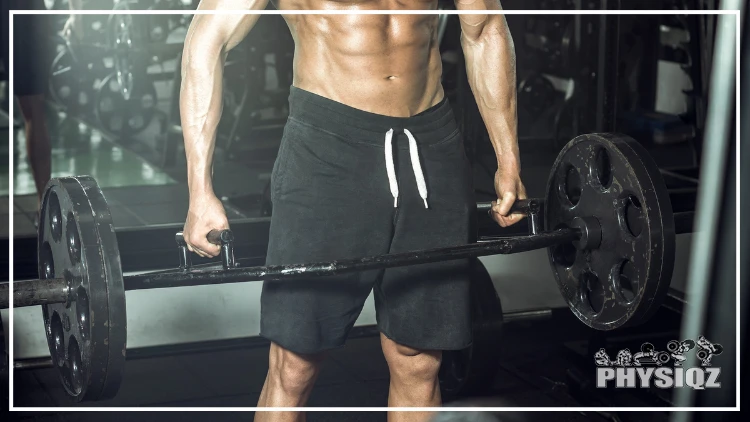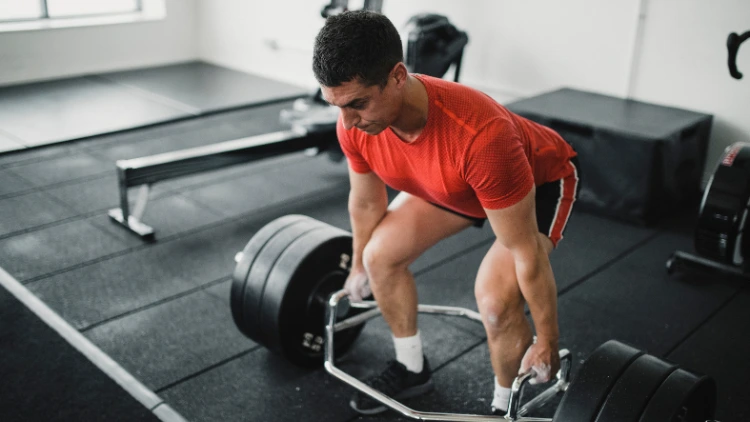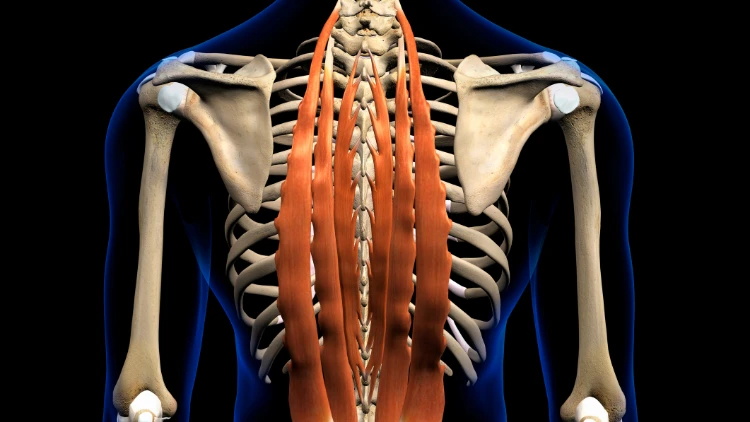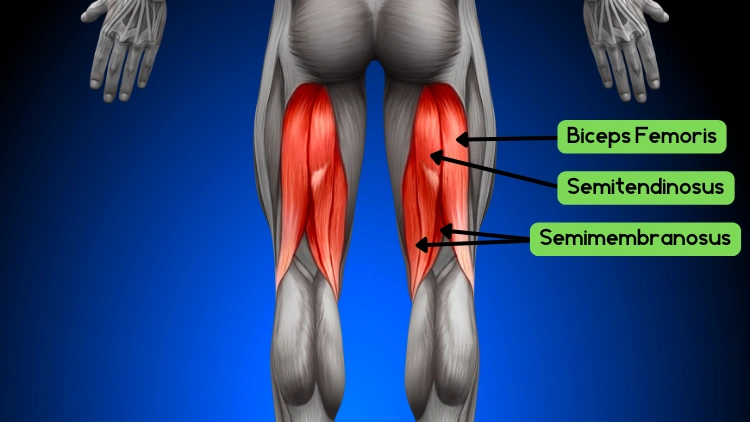
In the trap bar deadlift muscles worked include the hamstrings, glutes, and spinal erectors, but it will also use the quadriceps, adductors, and abductors as secondary movers.1 Overall, the hex bar deadlift offers a litany of benefits when used in a mass program, similar to what the normal deadlift offers.
Both are excellent exercises for developing total body mass and strength and are great for beginners. Compared to traditional barbell deadlifts, the hex bar deadlift causes increased muscle activation in the quads and glutes, as well as reduced stress on the lower back.
To better understand the mechanisms through which this works, the various muscles the t-bar deadlift activates will be discussed, as well as how these muscles compare to those activated in the standard deadlift. Further, a sample trap bar deadlift mass program will be given to add on to its own day, or on top of another.
Trap Bar Deadlift: Muscles Worked (Which Muscles Are Targeted by Trap Bar Deadlifts?)
The muscles worked in a trap bar deadlift are the glutes, hamstrings, spinal erectors (lower back), quadriceps, adductors, abductors, and upper back. An avid lifter would notice – this sounds very similar to the muscles worked when performing a traditional deadlift, and they wouldn’t be wrong.
But, there are some key differences in which muscles are primarily activated.
Quadriceps: The Primary Move When It Comes to Trap Bar Deadlifts Muscles Worked
Out of all of the muscles used during the trap bar deadlift, the quadriceps are the most important for this lift.
In the traditional deadlift, the center of mass is placed in front of a person’s body. The barbell is lifted in a straight up and down motion, but because a person has to lean forward to reach the barbell and pull it up in front of their body, the weight is skewed toward the front.

Source: SolStock via Canva.com2
This means that the glutes, hamstrings, and lower back are activated to a high degree.
But in the trap bar deadlift, the weight is centered on the body. This is because the bar itself encircles the lifter, with the bar shape evenly distributing the weight around the body, making it require less stabilization than the standard deadlift.
The trap bar also forces the lifter to have slightly more knee flexion than in a regular deadlift, which offers greater stretch and muscle-building capacity for the quadriceps.
With that being said, this offers the benefit of placing the quads under significantly greater stress than the normal deadlift, and more often than not, allows an individual to lift more weight than they could with a conventional deadlift.
Erector Spinae (Spinal Erector Muscles To Develop the Lower Back)
The erector spinae are the muscles that run from the base of the sacrum (right above the glutes) all the way up the spine, along the spine. They help to extend the lower back and keep the body in an upright posture.

Source: Hank Grebe via Canva.com3
They play a crucial role in stabilizing and protecting the spine during exercises like the trap bar deadlift, primarily by keeping the spine in a neutral position, preventing any excessive bending or arching of the spine.
When performing any deadlift variation, these lower back muscles are significantly activated at all portions of the movement. When crouched down at the bottom of the movement, the lower back is flexed; once the bar is lifted up, the glutes flex forward to take some tension off of the erector spinae, but it is still activated since the spine must maintain a neutral position when standing with the bar in hand.
By working these muscles during the trap bar deadlift, an individual can develop the strength and stability of their lower back, which will ultimately benefit overall strength in other compound movements like the squat and overhead press.
Hamstrings (Less Activation Than the Standard Deadlift)
The hamstrings are the muscles located at the back of the thighs beneath the glutes, connecting the buttocks to the knee, and they play an important role in assisting the glutes in extending the hips, which is their primary purpose when performing a deadlift.

Source: decade3d via Canva.com4
In the trap bar deadlift, these muscles will be less active than in a standard deadlift due to the altered center of mass. Since the weight is evenly distributed around the lifter and because there is greater knee flexion, the quads are recruited significantly more than in the traditional deadlift, leading to lesser hamstring activation.
However, the hex bar deadlift still does provide some activation for the hams, and it is still a great exercise for developing overall larger hamstrings.
Glutes & Hip Abductors & Adductors (Stabilization Muscles That Help You Lift More Weight)
The glutes and hip abductors and adductors all work in tandem with the hamstrings to extend the hips forward to lock out the trap bar deadlift at the top of the movement. The glutes are the main muscle out of this group of muscles that has an important effect on the deadlift, overall, while the hip stabilizers primarily assist in ensuring that the bar is raised in a controlled manner without unstable legs.
The Latissimus Dorsi (Lats), Rhomboideus (Rhomboids), Trapezius (Traps), Core, & Gastrocnemius Muscles (Less Activation Than Other Muscles)
The lats, rhomboids, traps, and gastrocnemius muscles are all important for stabilizing the torso during deadlift variations. Proper deadlift form, for any deadlift, requires a retracted scapula to stabilize the upper back; by default, this engages the rhomboids, traps, and lats.
For those curious about the areas impacted by deadlifts, it’s important to note that you’ll feel it in various muscles. However, proper deadlift form ensures these muscles are engaged at all times to prevent the upper chest from caving in mid-lift.
The gastrocnemius, on the other hand, is one of the many calf muscles but tends to be used during the deadlift as a way to stabilize the lower leg, but the calves are not worked through a significant range of motion throughout the trap bar deadlift, so don’t expect much hypertrophy from doing them alone.
The core muscles used in the deadlift, similar to a conventional deadlift, are used to stabilize the upper body and help prevent the chest from caving in, which is why those with bad ab genetics may find trap bar deadlifts easier than conventional ones – since the center of mass of the barbell is located under the center of the body in the t-bar deadlift, the upper back can work better in tandem with the core to keep the shoulders pinned back and down and the chest broad.
How Do Muscles Utilized in Trap Bar Deadlifts Differ From Those in a Sumo or Conventional Deadlift?
The muscles used in a trap bar deadlift are very similar to those used in conventional and sumo deadlifts. All three lifts involve the quadriceps, hamstrings, erector spinae, glutes, abductors and adductors, and upper back muscles.
However, the trap bar deadlift has a few key differences that make it unique; it is similar to how a high bar vs low bar squat offers a different muscle focus.
As aforementioned, the weight is evenly distributed around the body in a trap bar deadlift, making it less necessary for the hamstrings to be as active as they are in a conventional deadlift; on the flipside of the coin, the sumo deadlift shares similar muscle activation in the lower legs, including in the quadriceps, when compared to the trap bar deadlift.
Research shows that the hex bar deadlift shows significantly more activation in the quadriceps muscle when compared to the traditional deadlift, as well as less spinal erector muscle activation.5 The sumo deadlift, in comparison to the traditional deadlift, shows similar muscle activation patterns, also when compared to the standard deadlift, meaning the trap bar deadlift muscles worked are very similar to those working in the sumo deadlift.6
However, the core difference between the sumo deadlift and the trap bar deadlift is that the sumo deadlift still has the center of mass located in front of the body, meaning that there will be slightly more hinging at the hips, requiring a bit more erector spinae activation when compared to the trap bar deadlift. It also has a shorter range of motion than the trap bar deadlift, so there will be less overall knee flexion and less need for the hamstrings and glutes to ‘lock out’ the movement.
To sum things up, the trap bar deadlift is extremely effective for targeting the quadriceps due to its large amount of knee flexion. In contrast, the conventional deadlift is best for hamstring activation.
The sumo deadlift is a bit in between these; it activates the quadriceps less than the t-bar deadlift and more than the conventional deadlift, has more hamstring activation than the t-bar and less than the conventional and has less overall glute activation than either.
But, the research cited above also noted that the trap bar deadlift and conventional deadlift both elicited similar lower back muscle activation, so ultimately, swapping between deadlift variations should come down to what leg muscles a person wants to prioritize.
Do Hex Bar Deadlifts Work More Muscles Than Romanian Deadlifts or Kettlebell Swings?
Mark Rippetoe, a famous American author, powerlifter, and strength training coach is not a huge proponent of the trap bar deadlift. In fact, in a video discussing the t-bar, he essentially argues why it is a poor version of the traditional deadlift.
But the core message to take away from this video is about the mechanics required during deadlifting.
The hex bar deadlift, as it has already been discussed, has been affirmed to be relatively taxing – it uses quite a bit of skeletal muscle throughout the movement, including most of the leg muscles, the lower and upper back, and even the forearms to hold the bar itself. But due to the center of mass being located in the center, the human body is significantly safer when performing the movement when compared to the Romanian deadlift (RDL).
The RDL follows a similar bar path to the standard deadlift but requires a person to focus more on hip flexion rather than knee extension; think of it as similar to the squat bar path, but moving in the opposite direction.
It is set up like a normal deadlift, but after the bar has been ‘locked out’, it is slowly lowered by slightly bending the knee, pushing the glutes back until the bar touches the ground. This places the majority of the focus on stretching the hamstrings and glutes.
At the same time, it requires the lower back to be flexed to stabilize through the spine. This puts a large amount of tension on the lower back; less than the conventional deadlift, but more than the trap bar deadlift.
Kettlebell swings, on the other hand, use similar muscles to the RDL and trap bar deadlift, but also incorporate more upper-body musculature usage. It is overall safer than either the trap bar deadlift or RDL, though, because it is typically done with a lighter weight with a focus on an explosive concentric and a slightly controlled eccentric.
Since so many other muscles are being used, the lower back is taxed less than in either the trap bar deadlift or the RDL.
To sum it up, the Romanian deadlift is the most taxing due to its amplified stress on the lower back, with kettlebell swings being the least taxing of the three movements.
Is There Any Difference Between Diamond Bar Deadlifts vs T-Bar Deadlifts vs Trap Bar vs Hex Bar?
There are many different words used to describe the trap bar deadlift, including the diamond bar deadlift, t-bar deadlift, and hex bar deadlift. But all of these words do indeed mean the same movement.
No one knows where the differences in name stemmed from, but it is likely because the bar does look like all of the various shapes referenced – a ‘trap’ bar, a hex bar, and a diamond bar. Regardless, if a person is looking into the muscles engaged by trap bar deadlifts, searching for any of these terms will provide the correct information.
Benefits of Trap Bar Deadlifts
The trap bar deadlift is a good exercise because it is a safe deadlift variation that is very beginner-friendly while also targeting a significant amount of skeletal muscle.
It is a full-body exercise, targeting the quadriceps, glutes, hamstrings, and lower back as primary movers, with the core, lats, calves, and hip abductors/adductors helping as secondary movers. One benefit that it has over the traditional deadlift is that it offers a greater range of motion, allowing greater knee flexion and extension, leading to more of a focus on the quadriceps.
The trap bar deadlift is also great for athletes, as it provides an opportunity to lift more weight than they can in the traditional barbell deadlift. It provides stability and balance in the upper and lower body while also allowing for a more explosive and dynamic movement.
This makes it beneficial for athletes who are involved in sports such as football, rugby, or hockey, where speed and power are crucial for setting themselves apart from competitors.
Finally, because of its setup and the resulting mechanics, the T-bar row is less taxing on the lower back than the conventional deadlift, making it a great option for those who may experience back pain when performing regular deadlifts. This also means that the recovery needed after performing a trap bar deadlift is significantly less than other deadlift variations, meaning it is good for those who work out frequently; keep in mind that this is the main reason why squat and deadlift same day is not viable – it is too taxing on the body.
Overall, the trap bar deadlift is a great exercise for everyone, from professional athletes to those who are just beginning their journey into strength training. It works many muscles in the body, providing virtually all of the muscles in the body with some form of stimulus, and is safer than other deadlift variations.
It’s also great for those who experience back pain, as it is less taxing on the lower back.
How To Deadlift with a Trap Bar for Mass (How to Perform a Trap Bar Deadlift)
To use the trap bar deadlift for building muscle mass, a person should consider including this deadlift variation 1-2x per week. There is ample evidence that shows that training a muscle multiple times per week is optimal for long-term growth and muscle synthesis when compared to doing it less frequently, making this movement great for lower body mass gaining.7
This also means that a person should focus on using lighter weights with higher repetitions for the trap bar deadlift when doing it multiple times per week. Heavier weights tend to be used for compound exercises like the squat and bench press to achieve strength gains; but, to gain mass, doing more repetitions makes more sense.
This will also help to allow the body to recover more easily, since heavier weights tend to put more stress on the central nervous system (CNS) than lighter weights.
Keep in mind here that getting ample recovery, including eating a good diet and getting proper sleep is extremely important for recovery from resistance training.8 Without giving the body time to rest in between deadlift sessions, the CNS can easily be overtaxed and lead to diminished gains, hormonal issues, and general fatigue.
But, with proper rest, trap bar deadlifting multiple times per week is safe and can potentially lead to fantastic gains.
Want Something More Challenging? Try Out a Lowered Trap Bar Deadlift
By standing on top of a platform or even a few plates, the trap bar deadlift can become significantly more challenging. This involves setting up a stack of plates, standing on top of them, and using a trap bar to perform the deadlift from a deficit.
Although the t-bar deadlift already has a greater range of motion than the traditional deadlift, doing it from an elevated position will increase the range of motion for the movement, making it more challenging and requiring greater strength.
The main benefits of this include even greater knee flexion than normal, and training the quadriceps in a very stretched position that many lifters never have to perform. It will also require the movement to take ever so slightly longer since a person has to squat lower, meaning it will have an even better hypertrophic and cardiovascular benefit than the typical trap bar deadlift.
Sample Routine for Trap Bar Deadlifts
For an individual focused on a combination of strength and hypertrophy gains, a mix of trap bar deadlift variations should be used. However, considering it is still taxing on the overall body, not too much volume is used, but it can still be used as part of a good mass program.
This routine accounts for these factors and focuses on benefiting the body through a combination of low repetitions, high repetitions, and isometric contractions and is a bit different from a standard deadlift workout.
Current research also suggests that doing routines of 3-6 sets with somewhere between 6-12 repetitions can be best to lead to increased hypertrophy, accounting for the normal deadlift variation.9
- Trap bar deficit deadlift: 3 sets of 4-6 reps (strength-focused)
- Trap bar (normal) deadlift: 3 sets of 10-12 reps (hypertrophy-focused)
- Trap bar deadlift walks: 2 sets of 30-60 seconds (stabilization and forearm-focused)
Understanding How to Program Trap Bar Deadlifts
Trap bar deadlift muscles worked in the above routine, as aforementioned, will target the quads, glutes, and hamstrings primarily. It is better for developing overall maximal force, velocity, and power than the traditional barbell deadlift, suggesting it may be better for athletes who need to focus on speed and power output.10
The deficit deadlift will target strength gains and better knee flexion, while the normal t-bar deadlift will help a person to get some hypertrophy gains. The trap bar deadlift walk will allow a person to gain strength carrying a heavy weight that is centered on their body, allowing the entire musculature to get a stimulus from stabilizing and preventing the weight from falling to the floor.
Incorporating any of these individual movements on a non-deadlift-focused day can be beneficial, but strength should be kept in mind. The deficit hex bar deadlift should be added as a primary movement on a lower body day when trying to achieve strength gains.
The standard trap bar deadlift can be used as a secondary exercise to get more muscle activation, potentially after a squat.
T-bar deadlift walks, on the other hand, can realistically be used on any day; they won’t be super taxing on the body but will help to develop forearm strength and better posture throughout the entire body, so adding them onto an upper body day, or a push or pull day can be a great way to burn out the forearms and back stabilizers, like the rear delts and lats.
The trap bar deadlift is an exercise that is very safe for the back, prioritizing knee flexion and growth of the quadriceps more than other deadlift variations. This means for the trap bar deadlift, the muscles worked are slightly different but still offer a litany of different benefits when compared to other deadlift variants.
Frequently Asked Questions
What Does Trap Bar Deadlift Work if Done on a Deficit?
Trap bar deadlifts performed at a deficit will primarily work the quads, glutes, and hamstrings, with an emphasis on knee flexion. Since it requires the lifter to squat to a very low position, there is ultimately more leg drive than in other deadlift variations, meaning the quads are activated more, and the lower back is activated less.
What Do Trap Bar Deadlifts Work if You Pause Mid-Way or Below the Knees?
Any form of a pause deadlift will place more tension on the quadriceps – holding a heavy weight while the knee extensors are stretched ensures this. So, for someone who wants to target their quadriceps even more, doing a paused trap bar deadlift would be a good idea.
Does Trap Bar Deadlift Work Back?
Yes, the trap bar deadlift does work the back muscles. It elicits similar activation of the lower back to the traditional deadlift and requires the lats to help stabilize the movement slightly more, so it can be beneficial for developing overall strength and size in the back.
References
1Ozimician. Canva. Accessed 18 04 2023. <https://www.canva.com/photos/MADFHg0GaCI-trap-bar-deadlift/>
2SolStock. Canva. Accessed 18 April 2023. <https://www.canva.com/photos/MAEIyC-u1uo-deadlifting-a-weighted-bar/>
3Grebe, Hank. Canva. Accessed 18 04 2023. <https://www.canva.com/photos/MAD8-XkZ3xQ-male-erector-spinae-back-muscles-in-isolation-on-skeleton/>
4decade3d. Canva. Accessed 18 April 2023. <https://www.canva.com/photos/MADerMxdfBI-hamstrings-anatomy-muscles/>
5Andersen, V., Fimland, M., Mo, D.-A., Iversen, V., Vederhus, T., Hellebo, L., Nordaune, K., & Saeterbakken, A. (2018). Electromyographic Comparison of Barbell Deadlift, Hex Bar Deadlift, and Hip Thrust Exercises: A Cross-Over Study. Journal of Strength and Conditioning Research, 32(3), 587-593. <https://pubmed.ncbi.nlm.nih.gov/28151780/>
6Escamilla, R., Francisco, A., Kayes, A., Speer, K., & Moorman, C. (2002). An electromyographic analysis of sumo and conventional style deadlifts. Medicine & Science in Sports & Exercise, 34(4), 682-8. <https://pubmed.ncbi.nlm.nih.gov/11932579/>
7Schoenfeld, B., Ogborn, D., & Krieger, J. (2016). Effects of Resistance Training Frequency on Measures of Muscle Hypertrophy: A Systematic Review and Meta-Analysis. Sports Medicine, 46(11), 1689-1697. <https://pubmed.ncbi.nlm.nih.gov/27102172/>
8Knowles, O., Drinkwater, E., Urwin, C., Lamon, S., & Aisbett, B. (2018). Inadequate sleep and muscle strength: Implications for resistance training. Journal of Science and Medicine in Sport, 21(9), 959-968. <https://pubmed.ncbi.nlm.nih.gov/29422383/>
9Krzysztofik, M., Wilk, M., Wojdala, G., & Golas, A. (2019). Maximizing Muscle Hypertrophy: A Systematic Review of Advanced Resistance Training Techniques and Methods. International Journal of Environmental Research and Public Health, 16(24), 4897. <https://www.ncbi.nlm.nih.gov/pmc/articles/PMC6950543/>
10Camara, K., Coburn, J., Dunnick, D., Brown, L., Galpin, A., & Costa, P. (2016). An Examination of Muscle Activation and Power Characteristics While Performing the Deadlift Exercise With Straight and Hexagonal Barbells. Journal of Strength and Conditioning Research, 30(5), 1183-8. <https://pubmed.ncbi.nlm.nih.gov/26840440/>